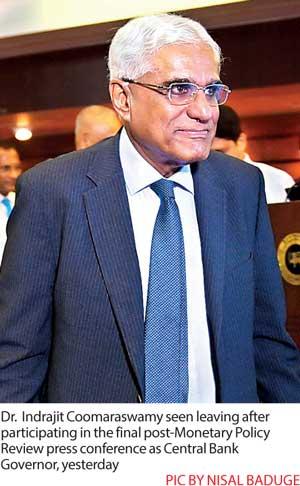30 Nov 2019 - {{hitsCtrl.values.hits}}
 By Nishel Fernando
By Nishel Fernando
As expected, the Central Bank (CB) maintained policy rates at current levels, mainly due to the recent developments on the fiscal front, which includes the recently introduced fiscal stimulus by the new government.
“Even before the fiscal stimulus package, which came in couple of days ago, there were certain fiscal measures, including pending salary hike, which argues some degree of caution in loosening the monetary policy,” CB Governor Dr. Indrajit Coomaraswamy told reporters in Colombo, addressing his final post-Monetary Policy Review press conference, yesterday.
Accordingly, the Monetary Board of the CB decided on Thursday to maintain the Standing Deposit Facility Rate (SDFR) and Standing Lending Facility Rate (SLFR) of the CB at their current levels of 7.00 percent and 8.00 percent, respectively.
“While noting the fiscal slippages thus far during the year, the Monetary Board observed that the recent tax revisions would support lower inflation and higher economic growth in the short term but was of the view that greater clarity with regard to the medium-term fiscal path of the government is required to assess the impact on the economy over the medium term,” the CB stated.
The governor pointed out that the CB has already taken a wide range of measures to address low GDP growth and low credit expansion in the economy, including 2.5 percent reduction in the Statutory Reserve Ratio (SRR) and 100 basis-point reductions in policy rates.
Further, he noted that the CB expanded its open market operations to include treasury bonds while imposing deposit and lending rate caps on banks to bring down high cost of financing.
The private sector credit, in absolute terms, recorded an increase of Rs.26 billion in October, following an increase of Rs.53.7 billion in September. On a cumulative basis, the private sector credit increased by Rs.144.6 billion during the first 10 months.
“The private sector credit growth is well below what we expected. Originally, we expected the credit disbursements to the private sector to grow by Rs.750 billion in absolute terms for the year. However, it’s most likely to be around Rs.250 or 270 billion the year now,” Dr. Coomaraswamy said
However, he noted that the policy measures adopted by the CB in recent months are still being transmitted to the economy through the financial market with the market lending rates
declining as envisaged.
“We expect prime lending rates to come down by 70 basis points by end-December and the average weighted lending rates to come down by 120 basis points
by March,” he added
.
Despite the expected volatility in inflation in short term, the CB expects the inflation to return to the desired range of 4-6 percent during the course of next year.
“There was uptick inflation during the past couple of months. In December, we expect the inflation to reach the upper bound of 6 percent. The inflation expectations are well anchored and outlook is stable. We expect the inflation to come down to mid-digit level during next year,” Dr. Coomaraswamy remarked.
However, the announced tax cuts and planned public sector wage increase could have a direct upward impact on aggregate demand in 2020. Thus, during the year, the exchange rate appreciated by 1.3 percent. In the first 10 months, the CB purchased US $ 303 million from the market on a net basis.
The gross official reserves have increased to US $ 7.8 billion by end-October.
.
15 Nov 2024 1 hours ago
15 Nov 2024 2 hours ago
15 Nov 2024 4 hours ago
15 Nov 2024 4 hours ago
15 Nov 2024 4 hours ago